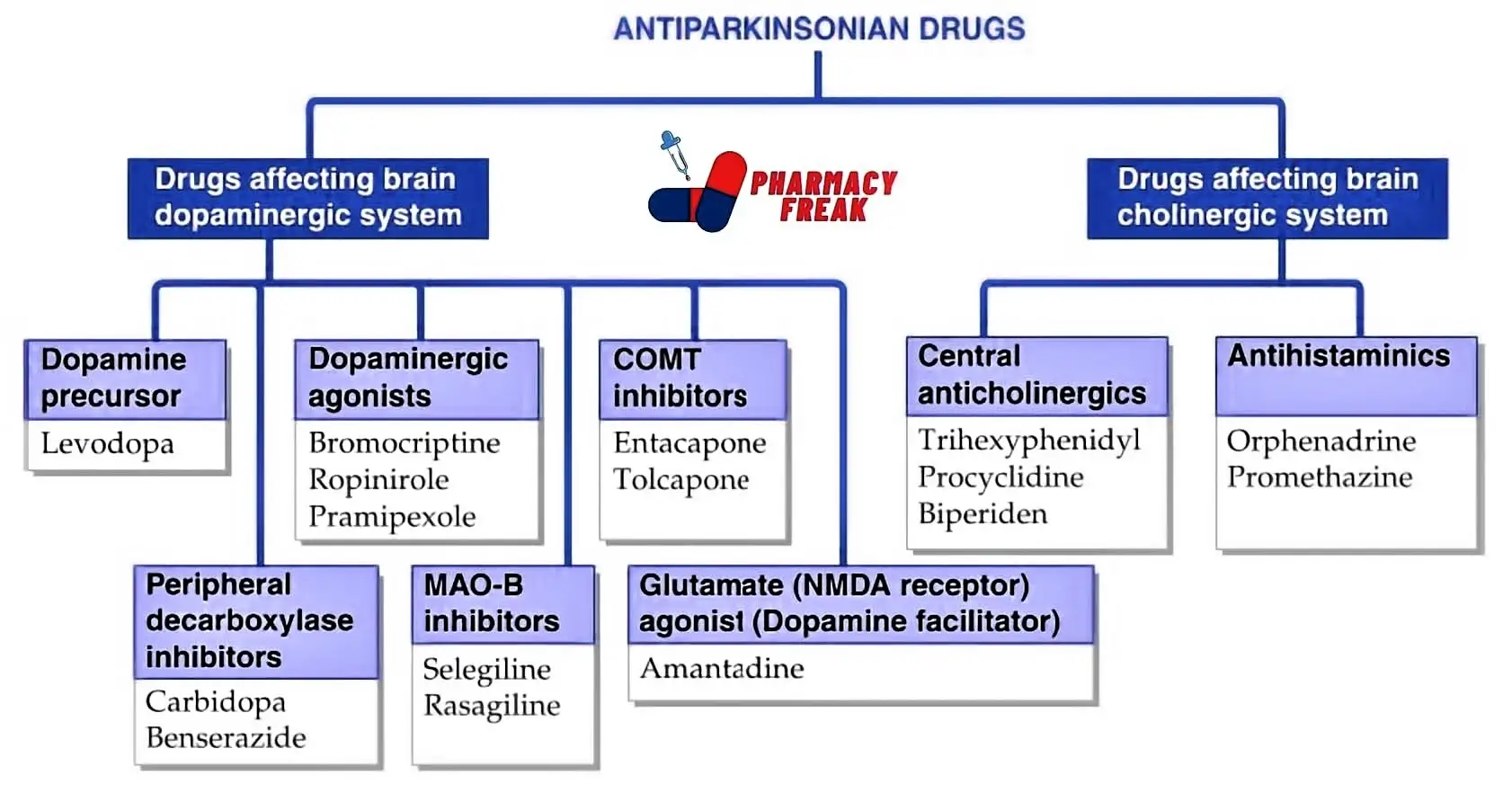Antiparkinsonian drugs are typically categorized into several classes based on their mechanisms of action and how they address the neurological imbalances associated with Parkinson’s disease. Each class targets specific neurotransmitters and pathways in the brain. Here are the primary classes of antiparkinsonian drugs:
- Drugs affecting brain dopaminergic system
- Dopamine precursor- Levodopa
- Peripheral decarboxylase inhibitors– Carbidopa, Benserazide
- Dopaminergic agonists– Bromocriptine, Ropinirole, Pramipexole
- MAO-B inhibitors– Selegiline, Rasagiline
- COMT inhibitors- Entacapone, Tolcapone
- Glutamate (NMDA receptor) agonist (Dopamine facilitator)– Amantadine
- Drugs affecting brain cholinergic system
- Central anticholinergics– Trihexyphenidyl, Procyclidine, Biperiden
- Antihistaminics– Orphenadrine, Promethazine
Dopamine Precursors
One of the hallmark features of Parkinson’s disease is a deficiency of dopamine, a neurotransmitter responsible for controlling movement. Dopamine precursor drugs are substances that the body can convert into dopamine. Levodopa is the most well-known and widely used dopamine precursor. Levodopa is often administered in combination with another medication called carbidopa to enhance its effectiveness and reduce side effects. Common medications in this class include:
- Levodopa-Carbidopa (Sinemet)
- Levodopa-Benserazide (Prolopa)
Dopamine Agonists
Dopamine agonists are medications that directly stimulate dopamine receptors in the brain. They mimic the action of dopamine, helping to alleviate motor symptoms. These drugs are often used in early-stage Parkinson’s disease or in conjunction with levodopa. Some common dopamine agonists are:
- Pramipexole (Mirapex)
- Ropinirole (Requip)
- Rotigotine (Neupro) (a dopamine agonist patch)
MAO-B Inhibitors
Monoamine oxidase type B (MAO-B) is an enzyme that breaks down dopamine in the brain. MAO-B inhibitors prevent the breakdown of dopamine, thereby increasing its availability. These drugs are typically used as monotherapy or in combination with other antiparkinsonian medications. Examples include:
- Selegiline (Eldepryl)
- Rasagiline (Azilect)
COMT Inhibitors
Catechol-O-methyltransferase (COMT) is another enzyme that breaks down levodopa in the bloodstream. COMT inhibitors prevent this breakdown, allowing more levodopa to reach the brain. They are often used in combination with levodopa. Common COMT inhibitors include:
- Entacapone (Comtan)
- Tolcapone (Tasmar)
Anticholinergics
Anticholinergic drugs block the action of acetylcholine, a neurotransmitter that can become overactive in Parkinson’s disease, leading to tremors and muscle rigidity. These medications can help manage some of the non-motor symptoms of the disease. Some anticholinergic drugs include:
- Trihexyphenidyl (Artane)
- Benztropine (Cogentin)
Amantadine
Amantadine is a unique medication that can help alleviate symptoms in early Parkinson’s disease. Its exact mechanism of action is not fully understood, but it is thought to modulate dopamine release and affect other neurotransmitter systems. Amantadine is sometimes used in later stages of the disease to manage dyskinesias, which are involuntary movements often associated with long-term levodopa use.
Reference
- Classification of Progestins- KD Tripathi
- Science Direct- Antiparkinson Agent
Related Links

I am a Registered Pharmacist under the Pharmacy Act, 1948, and the founder of PharmacyFreak.com. I hold a Bachelor of Pharmacy degree from Rungta College of Pharmaceutical Science and Research. With a strong academic foundation and practical knowledge, I am committed to providing accurate, easy-to-understand content to support pharmacy students and professionals. My aim is to make complex pharmaceutical concepts accessible and useful for real-world application.
Mail- Sachin@pharmacyfreak.com
